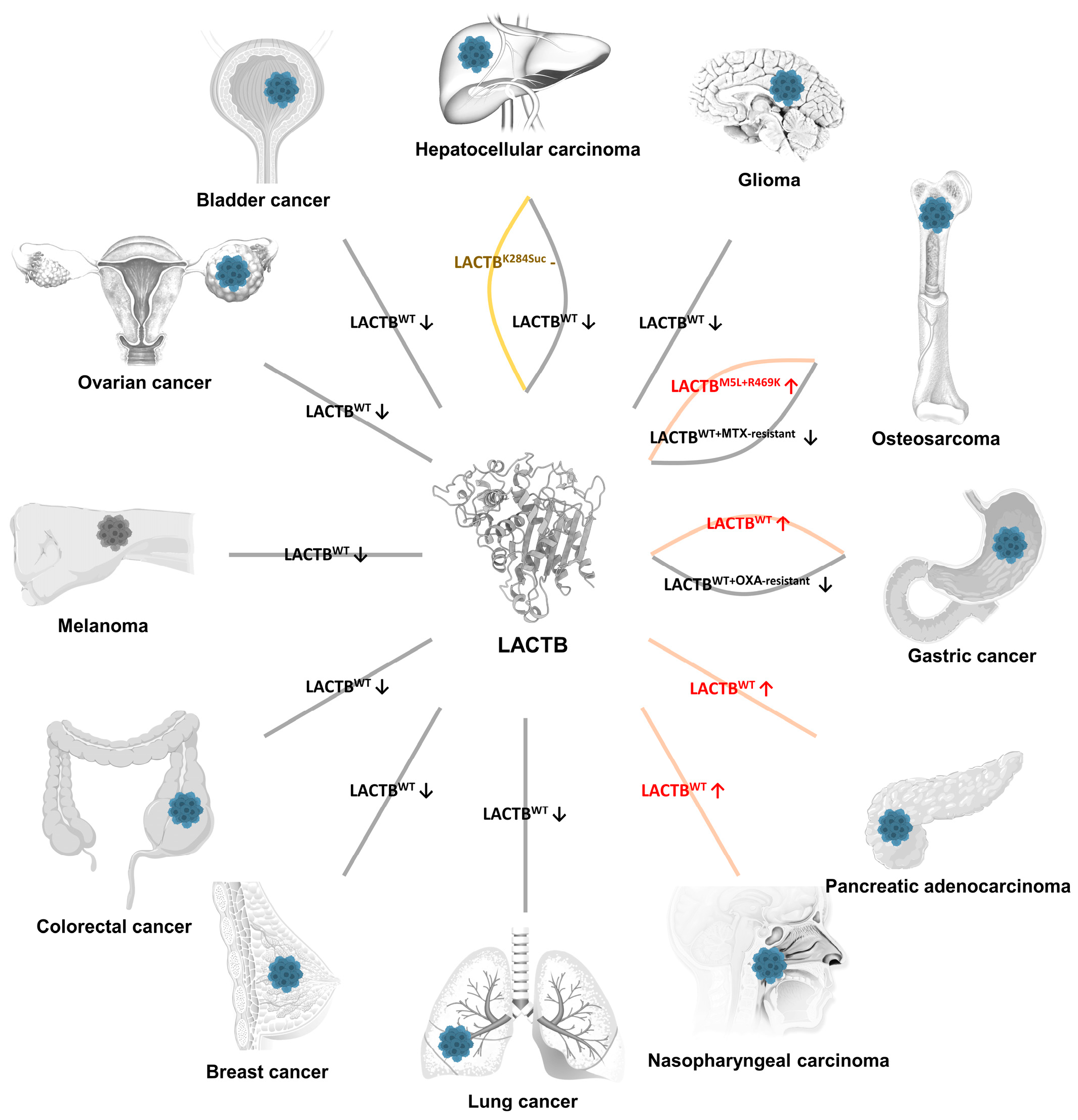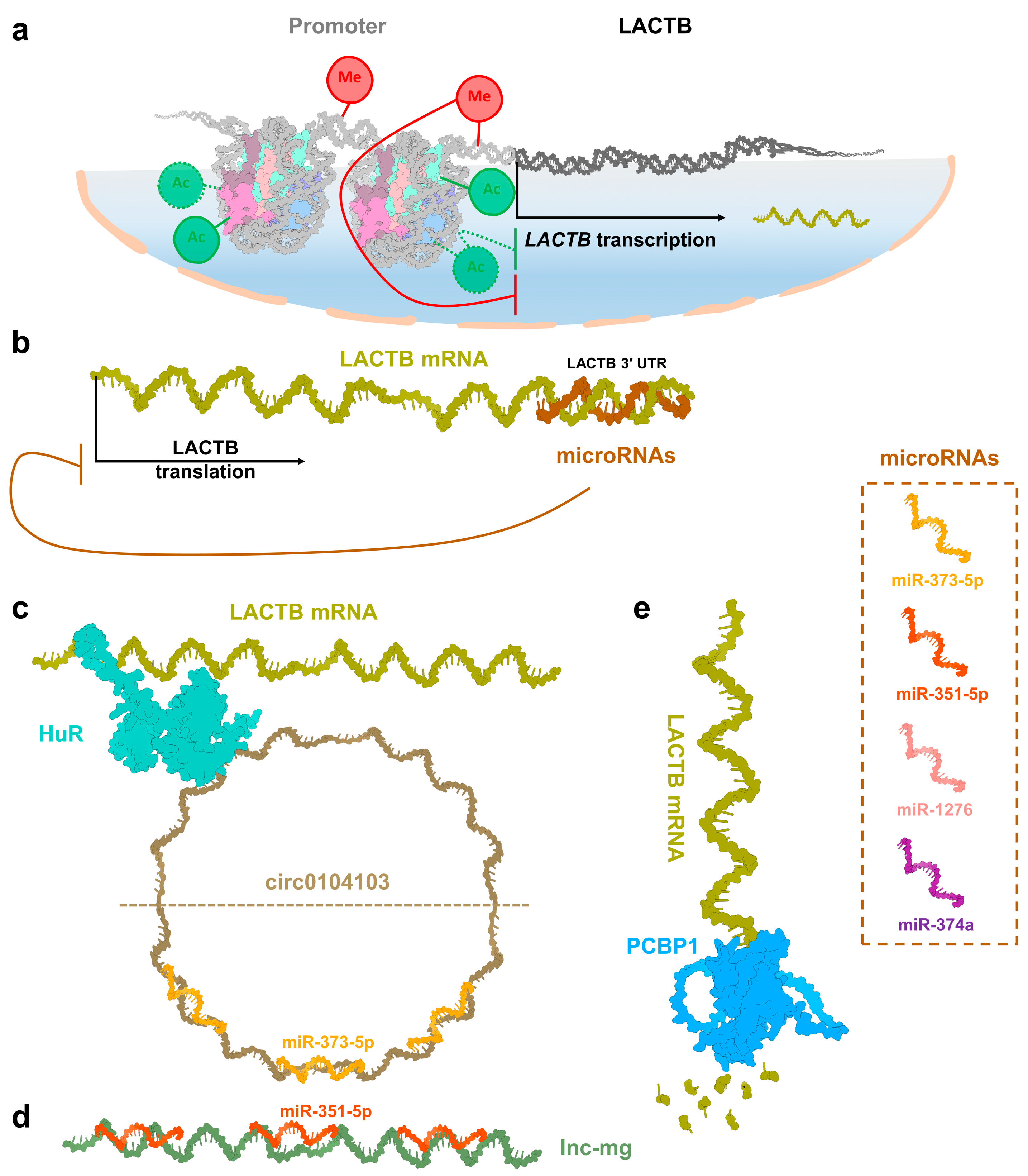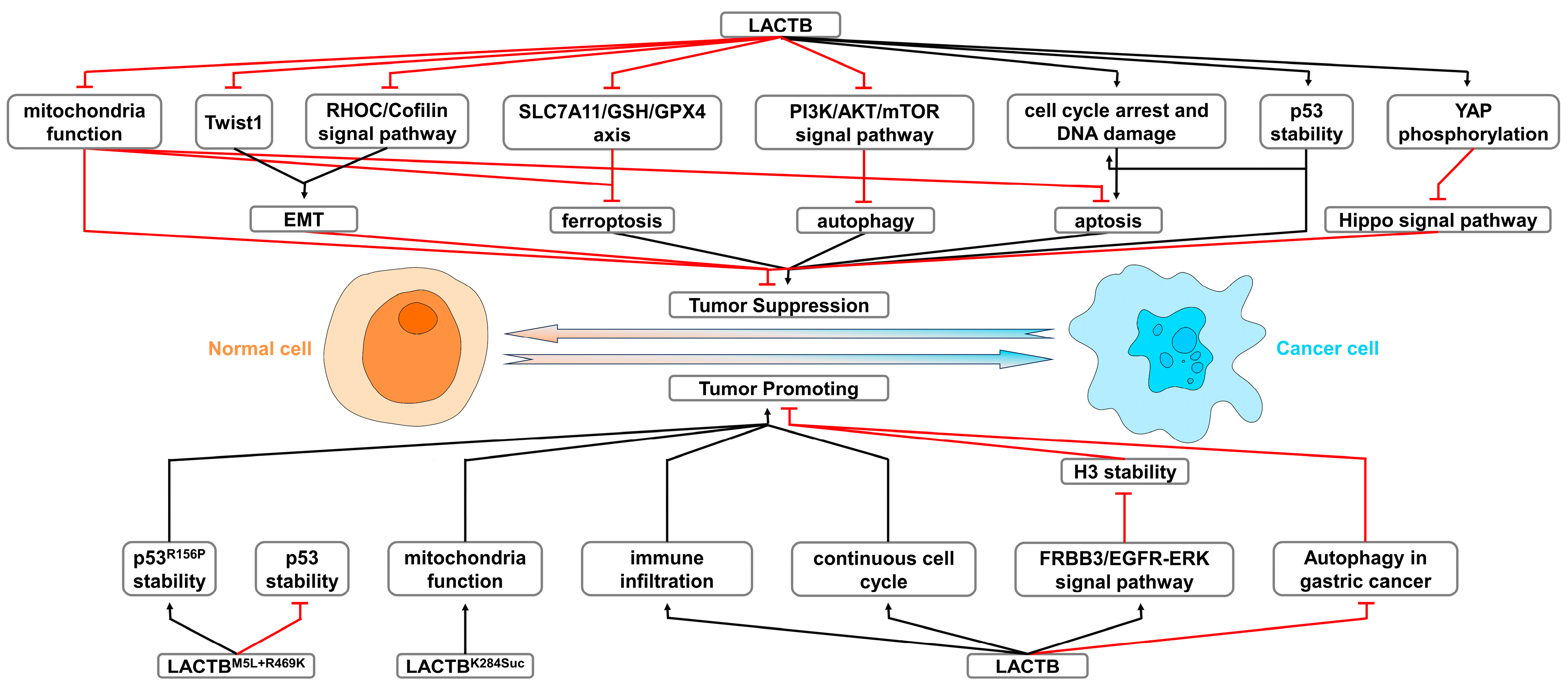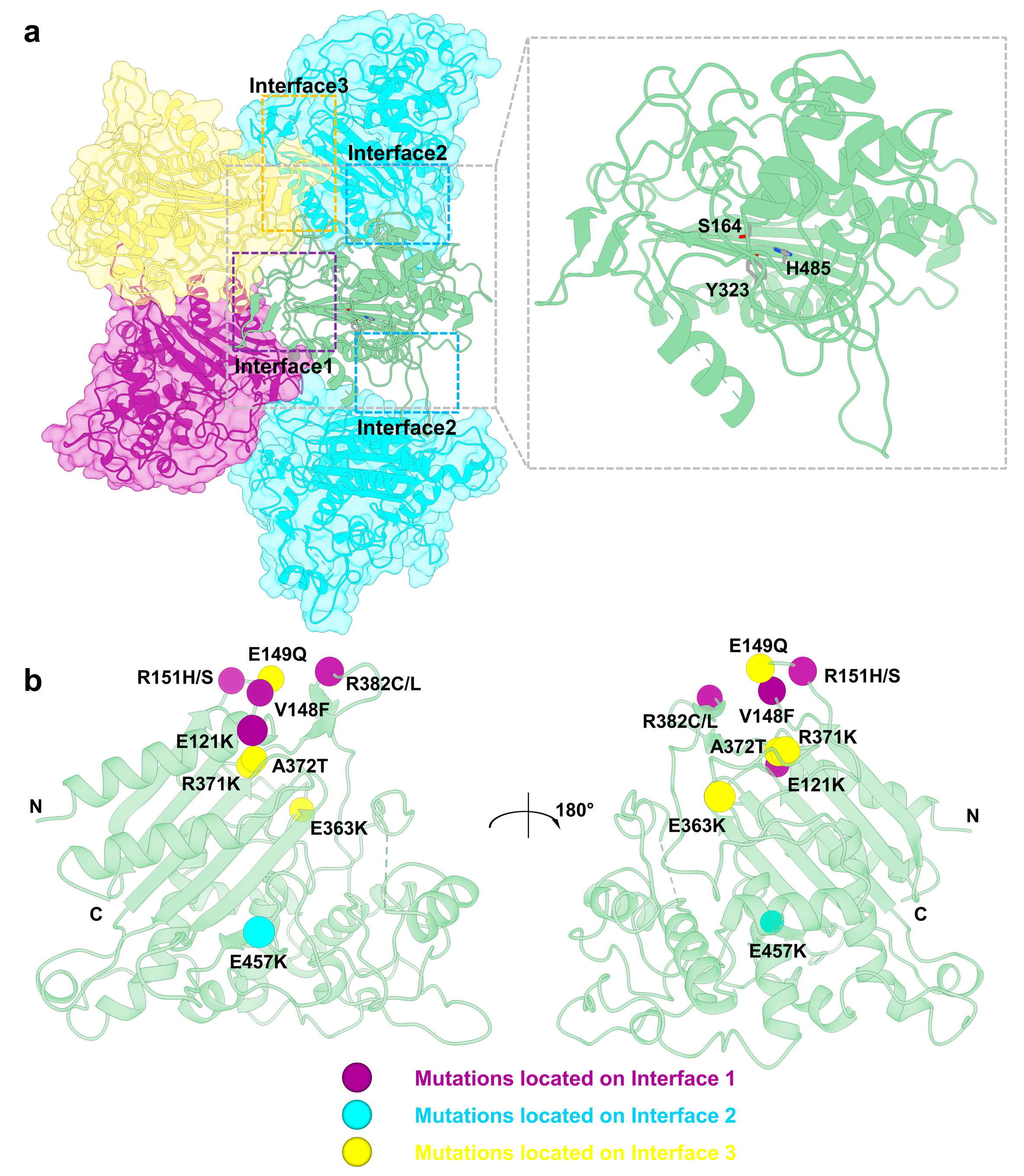The Pivotal Role of LACTB in the Process of Cancer Development
Abstract
1. Introduction
2. Expression Level of the LACTB in Different Cancers
2.1. Lung Cancer
2.2. Breast Cancer
2.3. Colorectal Cancer
2.4. Melanoma
2.5. Ovarian Cancer
2.6. Bladder Cancer
2.7. Hepatocellular Carcinoma
2.8. Glioma
2.9. Osteosarcoma
2.10. Gastric Cancer
2.11. Pancreatic Adenocarcinoma
2.12. Nasopharyngeal Carcinoma
3. Mechanistic Roles of LACTB in Cancer Cell Dynamics
3.1. Regulatory Mechanisms of LACTB Expression
3.2. Impact of LACTB on Mitochondrial Activity
3.3. Impact of LACTB on Epithelial–Mesenchymal Transition
3.4. Impact of LACTB on Cell Death Pathways
3.5. Impact of LACTB on p53-Dependent Cancer Suppression
3.6. Impact of LACTB on the Hippo Pathway
3.7. Impact of LACTB on Histone and Its Post-Translational Modifications
3.8. Impact of LACTB on Immune Infiltration
3.9. Impact of LACTB on Cell Cycle Arrest
4. Current Research on the Structure of LACTB and Its Association with Cancer
5. Investigation of LACTB as a Target for Precision Medicine in Cancer
6. Conclusions and Perspectives
Author Contributions
Funding
Institutional Review Board Statement
Informed Consent Statement
Data Availability Statement
Conflicts of Interest
References
- Zhang, M.; Zhang, L.; Guo, R.; Xiao, C.; Yin, J.; Zhang, S.; Yang, M. Structural basis for the catalytic activity of filamentous human serine beta-lactamase-like protein LACTB. Structure 2022, 30, 685.e5–696.e5. [Google Scholar] [CrossRef]
- Polianskyte, Z.; Peitsaro, N.; Dapkunas, A.; Liobikas, J.; Soliymani, R.; Lalowski, M.; Speer, O.; Seitsonen, J.; Butcher, S.; Cereghetti, G.M.; et al. LACTB is a filament-forming protein localized in mitochondria. Proc. Natl. Acad. Sci. USA 2009, 106, 18960–18965. [Google Scholar] [CrossRef] [PubMed]
- Bennett, J.A.; Steward, L.R.; Rudolph, J.; Voss, A.P.; Aydin, H. The structure of the human LACTB filament reveals the mechanisms of assembly and membrane binding. PLoS Biol. 2022, 20, e3001899. [Google Scholar] [CrossRef] [PubMed]
- Cucchi, D.; Mauro, C. LACTB-mediated tumour suppression by increased mitochondrial lipid metabolism. Cell Death Differ. 2017, 24, 1137–1139. [Google Scholar] [CrossRef] [PubMed]
- Gonzalez-Franquesa, A.; Stocks, B.; Chubanava, S.; Hattel, H.B.; Moreno-Justicia, R.; Peijs, L.; Treebak, J.T.; Zierath, J.R.; Deshmukh, A.S. Mass-spectrometry-based proteomics reveals mitochondrial supercomplexome plasticity. Cell Rep. 2021, 35, 109180. [Google Scholar] [CrossRef]
- Lu, J.-B.; Yao, X.-X.; Xiu, J.-C.; Hu, Y.-W. MicroRNA-125b-5p attenuates lipopolysaccharide-induced monocyte chemoattractant protein-1 production by targeting inhibiting LACTB in THP-1 macrophages. Arch. Biochem. Biophys. 2016, 590, 64–71. [Google Scholar] [CrossRef]
- Du, J.; Zhang, P.; Zhao, X.; He, J.; Xu, Y.; Zou, Q.; Luo, J.; Shen, L.; Gu, H.; Tang, Q.; et al. MicroRNA-351-5p mediates skeletal myogenesis by directly targeting lactamase-beta and is regulated by lnc-mg. FASEB J. 2019, 33, 1911–1926. [Google Scholar] [CrossRef]
- Chambers, T.L.; Dimet-Wiley, A.; Keeble, A.R.; Haghani, A.; Lo, W.-J.; Kang, G.; Brooke, R.; Horvath, S.; Fry, C.S.; Watowich, S.J.; et al. Methylome-proteome integration after late-life voluntary exercise training reveals regulation and target information for improved skeletal muscle health. J. Physiol. 2024, 603, 211–237. [Google Scholar] [CrossRef]
- Siegel, R.L.; Giaquinto, A.N.; Jemal, A. Cancer statistics, 2024. CA Cancer J. Clin. 2024, 74, 12–49. [Google Scholar] [CrossRef]
- Thai, A.A.; Solomon, B.J.; Sequist, L.V.; Gainor, J.F.; Heist, R.S. Lung cancer. Lancet 2021, 398, 535–554. [Google Scholar] [CrossRef]
- Xu, Y.; Shi, H.; Wang, M.; Huang, P.; Xu, M.; Han, S.; Li, H.; Wang, Y. LACTB suppresses carcinogenesis in lung cancer and regulates the EMT pathway. Exp. Ther. Med. 2022, 23, 247. [Google Scholar] [CrossRef] [PubMed]
- Giaquinto, A.N.; Sung, H.; Miller, K.D.; Kramer, J.L.; Newman, L.A.; Minihan, A.; Jemal, A.; Siegel, R.L. Breast Cancer Statistics, 2022. CA Cancer J. Clin. 2022, 72, 524–541. [Google Scholar] [CrossRef]
- Zhang, J.; He, Y.; Yu, Y.; Chen, X.; Cui, G.; Wang, W.; Zhang, X.; Luo, Y.; Li, J.; Ren, F.; et al. Upregulation of miR-374a promotes tumor metastasis and progression by downregulating LACTB and predicts unfavorable prognosis in breast cancer. Cancer Med. 2018, 7, 3351–3362. [Google Scholar] [CrossRef]
- Gonzalez-Morena, J.M.; Escudeiro-Lopes, S.; Ferreira-Mendes, J.M.; Jakoube, P.; Cutano, V.; Vinaixa-Forner, J.; Viziova, P.K.; Hartmanova, A.; Sedlacek, R.; Machado, S.; et al. LACTB induces cancer cell death through the activation of the intrinsic caspase-independent pathway in breast cancer. Apoptosis 2023, 28, 186–198. [Google Scholar] [CrossRef]
- Keckesova, Z.; Donaher, J.L.; De Cock, J.; Freinkman, E.; Lingrell, S.; Bachovchin, D.A.; Bierie, B.; Tischler, V.; Noske, A.; Okondo, M.C.; et al. LACTB is a tumour suppressor that modulates lipid metabolism and cell state. Nature 2017, 543, 681–686. [Google Scholar] [CrossRef]
- Wang, C.; Shi, Z.; Hong, Z.; Pan, J.; Chen, Z.; Qiu, C.; Zhuang, H.; Zheng, X. MicroRNA-1276 Promotes Colon Cancer Cell Proliferation by Negatively Regulating LACTB. Cancer Manag. Res. 2020, 12, 12185–12195. [Google Scholar] [CrossRef]
- Tan, P.; Sun, H.; Xu, M.; Liu, X.; Qin, J.; Nie, J.; Qin, X.; Wang, S.; Pan, Y. Circular RNA circ0104103 inhibits colorectal cancer progression through interactions with HuR and miR-373-5p. Cancer Sci. 2023, 114, 1396–1409. [Google Scholar] [CrossRef]
- Zhou, S.; Miao, L.; Li, T.; Liu, P.; Zhou, H. Clinical Significance of beta-Lactamase Expression in Colorectal Cancer. Cancer Biother. Radiopharm. 2022, 37, 939–944. [Google Scholar]
- Zeng, K.; Chen, X.; Hu, X.; Liu, X.; Xu, T.; Sun, H.; Pan, Y.; He, B.; Wang, S. LACTB, a novel epigenetic silenced tumor suppressor, inhibits colorectal cancer progression by attenuating MDM2-mediated p53 ubiquitination and degradation. Oncogene 2018, 37, 5534–5551. [Google Scholar] [CrossRef]
- Xu, W.; Yu, M.; Qin, J.; Luo, Y.; Zhong, M. LACTB Regulates PIK3R3 to Promote Autophagy and Inhibit EMT and Proliferation Through the PI3K/AKT/mTOR Signaling Pathway in Colorectal Cancer. Cancer Manag. Res. 2020, 12, 5181–5200. [Google Scholar] [CrossRef]
- Long, G.V.; Swetter, S.M.; Menzies, A.M.; Gershenwald, J.E.; Scolyer, R.A. Cutaneous melanoma. Lancet 2023, 402, 485–502. [Google Scholar] [CrossRef] [PubMed]
- Ma, Y.; Wang, L.; He, F.; Yang, J.; Ding, Y.; Ge, S.; Fan, X.; Zhou, Y.; Xu, X.; Jia, R. LACTB suppresses melanoma progression by attenuating PP1A and YAP interaction. Cancer Lett. 2021, 506, 67–82. [Google Scholar] [CrossRef] [PubMed]
- Liu, J.; Yang, L.; Yuan, X.; Xiong, M.; Zhu, J.; Wu, W.; Ren, M.; Long, J.; Xu, X.; Gou, M. Targeted Nanotherapeutics Using LACTB Gene Therapy Against Melanoma. Int. J. Nanomed. 2021, 16, 7697–7709. [Google Scholar] [CrossRef] [PubMed]
- Bray, F.; Laversanne, M.; Sung, H.; Ferlay, J.; Siegel, R.L.; Soerjomataram, I.; Jemal, A. Global cancer statistics 2022: GLOBOCAN estimates of incidence and mortality worldwide for 36 cancers in 185 countries. CA Cancer J. Clin. 2024, 74, 229–263. [Google Scholar] [CrossRef]
- Cutano, V.; Mendes, J.M.F.; Escudeiro-Lopes, S.; Machado, S.; Forner, J.V.; Gonzales-Morena, J.M.; Prevorovsky, M.; Zemlianski, V.; Feng, Y.; Viziova, P.K.; et al. LACTB exerts tumor suppressor properties in epithelial ovarian cancer through regulation of Slug. Life Sci. Alliance 2023, 6, e202201510. [Google Scholar] [CrossRef]
- Luo, Y.; Zhang, Y.; Pang, S.; Min, J.; Wang, T.; Wu, D.; Lin, C.; Xiao, Z.; Xiang, Q.; Li, Q.; et al. PCBP1 protects bladder cancer cells from mitochondria injury and ferroptosis by inducing LACTB mRNA degradation. Mol. Carcinog. 2023, 62, 907–919. [Google Scholar] [CrossRef]
- Xue, C.; He, Y.; Zhu, W.; Chen, X.; Yu, Y.; Hu, Q.; Chen, J.; Liu, L.; Ren, F.; Ren, Z.; et al. Low expression of LACTB promotes tumor progression and predicts poor prognosis in hepatocellular carcinoma. Am. J. Transl. Res. 2018, 10, 4152–4162. [Google Scholar]
- Zeng, K.; Huang, N.; Liu, N.; Deng, X.; Mu, Y.; Zhang, X.; Zhang, J.; Zhang, C.; Li, Y.; Li, Z. LACTB suppresses liver cancer progression through regulation of ferroptosis. Redox. Biol. 2024, 75, 103270. [Google Scholar] [CrossRef]
- Ma, W.; Sun, Y.; Yan, R.; Zhang, P.; Shen, S.; Lu, H.; Zhou, Z.; Jiang, Z.; Ye, L.; Mao, Q.; et al. OXCT1 functions as a succinyltransferase, contributing to hepatocellular carcinoma via succinylating LACTB. Mol. Cell 2024, 84, 538–551.e7. [Google Scholar] [CrossRef]
- Seecharan, D.; Pollack, A.; Farassati, F. Innovative Surgical Management of Glioma. Chapter 1. In Novel Therapeutic Concepts in Targeting Glioma; IntechOpen: Rijeka, Croatia, 2012; pp. 3–24. [Google Scholar]
- Li, H.T.; Dong, D.Y.; Liu, Q.; Xu, Y.Q.; Chen, L. Overexpression of LACTB, a Mitochondrial Protein That Inhibits Proliferation and Invasion in Glioma Cells. Oncol. Res. 2019, 27, 423–429. [Google Scholar] [CrossRef]
- Hu, Y.; Liu, H.; Zhu, Z.; Qi, X.; Yuan, W.; Tian, M.; Wang, D.; Xu, J. LACTB suppresses migration and invasion of glioblastoma via downregulating RHOC/Cofilin signaling pathway. Biochem. Biophys. Res. Commun. 2022, 629, 17–25. [Google Scholar] [CrossRef] [PubMed]
- Beird, H.C.; Bielack, S.S.; Flanagan, A.M.; Gill, J.; Heymann, D.; Janeway, K.A.; Livingston, J.A.; Roberts, R.D.; Strauss, S.J.; Gorlick, R. Osteosarcoma. Nat. Rev. Dis. Primers 2022, 8, 77. [Google Scholar] [CrossRef] [PubMed]
- Zhang, J.; Liu, W.; Zou, C.; Zhao, Z.; Lai, Y.; Shi, Z.; Xie, X.; Huang, G.; Wang, Y.; Zhang, X.; et al. Targeting Super-Enhancer-Associated Oncogenes in Osteosarcoma with THZ2, a Covalent CDK7 Inhibitor. Clin Cancer Res. 2020, 26, 2681–2692. [Google Scholar] [CrossRef] [PubMed]
- Huang, G.; Zhang, X.; Xu, Y.; Chen, S.; Cao, Q.; Liu, W.; Fu, Y.; Jia, Q.; Shen, J.; Yin, J.; et al. Prognostic and predictive value of super-enhancer-derived signatures for survival and lung metastasis in osteosarcoma. J. Transl. Med. 2024, 22, 88. [Google Scholar] [CrossRef]
- Huang, G.; Zhang, J.; Xu, Y.; Wu, F.; Fu, Y.; Zhang, X.; Yin, H.; You, Y.; Zhao, P.; Liu, W.; et al. SNPs Give LACTB Oncogene-Like Functions and Prompt Tumor Progression via Dual-Regulating p53. Adv. Sci. 2024, 11, e2405907. [Google Scholar] [CrossRef]
- Jiang, Z.; Han, K.; Min, D.; Kong, W.; Wang, S.; Gao, M. Identification of the methotrexate resistance-related diagnostic markers in osteosarcoma via adaptive total variation netNMF and multi-omics datasets. Front. Genet. 2023, 14, 1288073. [Google Scholar] [CrossRef]
- Smyth, E.C.; Nilsson, M.; Grabsch, H.I.; van Grieken, N.C.; Lordick, F. Gastric cancer. Lancet 2020, 396, 635–648. [Google Scholar] [CrossRef]
- Nie, W.; Hu, L.; Yan, Z.; Wang, Y.; Shi, Q.; He, S.; Wang, Q.; Yang, F. A potential therapeutic approach for gastric cancer: Inhibition of LACTB transcript 1. Aging 2023, 15, 15213–15227. [Google Scholar] [CrossRef]
- Yang, F.; Yan, Z.; Nie, W.; Cheng, X.; Liu, Z.; Wang, W.; Shao, C.; Fu, G.; Yu, Y. LACTB induced apoptosis of oxaliplatin-resistant gastric cancer through regulating autophagy-mediated mitochondrial apoptosis pathway. Am. J. Transl. Res. 2021, 13, 601–616. [Google Scholar]
- Yang, F.; Yan, Z.; Nie, W.; Liu, Z.; Cheng, X.; Wang, W.; Shao, C.; Fu, G.; Yu, Y. LACTB and LC3 could serve as potential biomarkers of gastric cancer to neoadjuvant chemotherapy with oxaliplatin plus S-1. Oncol. Lett. 2021, 21, 470. [Google Scholar] [CrossRef]
- Panchal, K.; Sahoo, R.K.; Gupta, U.; Chaurasiya, A. Role of targeted immunotherapy for pancreatic ductal adenocarcinoma (PDAC) treatment: An overview. Int. Immunopharmacol. 2021, 95, 107508. [Google Scholar] [CrossRef] [PubMed]
- Xie, J.; Peng, Y.; Chen, X.; Li, Q.; Jian, B.; Wen, Z.; Liu, S. LACTB mRNA expression is increased in pancreatic adenocarcinoma and high expression indicates a poor prognosis. PLoS ONE 2021, 16, e0245908. [Google Scholar] [CrossRef] [PubMed]
- Ramsey, T.; Hojjat, H.; Yuhan, B.; Svider, P.F.; Eloy, J.A.; Folbe, A.J.; Raza, S.N.; Fribley, A.M. Disparities in impact of nasopharyngeal cancer: An analysis of global health burden. Laryngoscope 2019, 129, 2482–2486. [Google Scholar] [CrossRef]
- Peng, L.-X.; Wang, M.-D.; Xie, P.; Yang, J.-P.; Sun, R.; Zheng, L.-S.; Mei, Y.; Meng, D.-F.; Peng, X.-S.; Lang, Y.-H.; et al. LACTB promotes metastasis of nasopharyngeal carcinoma via activation of ERBB3/EGFR-ERK signaling resulting in unfavorable patient survival. Cancer Lett. 2021, 498, 165–177. [Google Scholar] [CrossRef]
- Liu, Y.; Li, Q.; Song, L.; Gong, C.; Tang, S.; Budinich, K.A.; Vanderbeck, A.; Mathias, K.M.; Wertheim, G.B.; Nguyen, S.C.; et al. Condensate-Promoting ENL Mutation Drives Tumorigenesis In Vivo Through Dynamic Regulation of Histone Modifications and Gene Expression. Cancer Discov. 2024, 14, 1522–1546. [Google Scholar] [CrossRef]
- Kinslow, C.J.; Mercurio, A.; Kumar, P.; Rae, A.I.; Siegelin, M.D.; Grinband, J.; Taparra, K.; Upadhyayula, P.S.; McKhann, G.M.; Sisti, M.B.; et al. Association of MGMT Promoter Methylation With Survival in Low-grade and Anaplastic Gliomas After Alkylating Chemotherapy. JAMA Oncol. 2023, 9, 919–927. [Google Scholar] [CrossRef]
- Pineda Lancheros, L.E.; Tolosa, S.R.; Galvez Navas, J.M.; Martinez, F.M.; Martin, A.S.; Morales, A.J.; Ramirez, C.P. Effect of Single Nucleotide Polymorphisms in the Vitamin D Metabolic Pathway on Susceptibility to Non-Small-Cell Lung Cancer. Nutrients 2022, 14, 4668. [Google Scholar] [CrossRef]
- O’Brien, J.; Hayder, H.; Zayed, Y.; Peng, C. Overview of MicroRNA Biogenesis, Mechanisms of Actions, and Circulation. Front. Endocrinol. 2018, 9, 402. [Google Scholar] [CrossRef]
- Spinelli, J.B.; Haigis, M.C. The multifaceted contributions of mitochondria to cellular metabolism. Nat. Cell Biol. 2018, 20, 745–754. [Google Scholar] [CrossRef]
- Balakrishnan, K. Mitochondrial dysregulation is a key regulator of gastric cancer subtype carcinogenesis. Genome Instab. Dis. 2024, 5, 1–15. [Google Scholar] [CrossRef]
- Logan, D.C. The mitochondrial compartment. J. Exp. Bot. 2006, 57, 1225–1243. [Google Scholar] [CrossRef] [PubMed]
- Zheng, W.; Chai, P.; Zhu, J.; Zhang, K. High-resolution in situ structures of mammalian respiratory supercomplexes. Nature 2024, 631, 232–239. [Google Scholar] [CrossRef] [PubMed]
- Muhleip, A.; Flygaard, R.K.; Baradaran, R.; Haapanen, O.; Gruhl, T.; Tobiasson, V.; Marechal, A.; Sharma, V.; Amunts, A. Structural basis of mitochondrial membrane bending by the I-II-III(2)-IV(2) supercomplex. Nature 2023, 615, 934–938. [Google Scholar] [CrossRef] [PubMed]
- Nesterov, S.V.; Plokhikh, K.S.; Chesnokov, Y.M.; Mustafin, D.A.; Goleva, T.N.; Rogov, A.G.; Vasilov, R.G.; Yaguzhinsky, L.S. Safari with an Electron Gun: Visualization of Protein and Membrane Interactions in Mitochondria in Natural Environment. Biochemistry 2024, 89, 257–268. [Google Scholar] [PubMed]
- Anselmi, C.; Davies, K.M.; Faraldo-Gomez, J.D. Mitochondrial ATP synthase dimers spontaneously associate due to a long-range membrane-induced force. J. Gen. Physiol. 2018, 150, 763–770. [Google Scholar] [CrossRef]
- Golombek, M.; Tsigaras, T.; Schaumkessel, Y.; Hansch, S.; Weidtkamp-Peters, S.; Anand, R.; Reichert, A.S.; Kondadi, A.K. Cristae dynamics is modulated in bioenergetically compromised mitochondria. Life Sci. Alliance 2024, 7, e202302386. [Google Scholar] [CrossRef]
- Tamura, Y.; Kawano, S.; Endo, T. Lipid homeostasis in mitochondria. Biol. Chem. 2020, 401, 821–833. [Google Scholar] [CrossRef]
- Guerra, R.M.; Pagliarini, D.J. Coenzyme Q biochemistry and biosynthesis. Trends Biochem. Sci. 2023, 48, 463–476. [Google Scholar] [CrossRef]
- Zhang, Q.; Tamura, Y.; Roy, M.; Adachi, Y.; Iijima, M.; Sesaki, H. Biosynthesis and roles of phospholipids in mitochondrial fusion, division and mitophagy. Cell Mol. Life Sci. 2014, 71, 3767–3778. [Google Scholar] [CrossRef]
- Ball, W.B.; Neff, J.K.; Gohil, V.M. The role of nonbilayer phospholipids in mitochondrial structure and function. FEBS Lett. 2018, 592, 1273–1290. [Google Scholar] [CrossRef]
- Jaworski, W.; Szymkuc, S.; Mikulak-Klucznik, B.; Piecuch, K.; Klucznik, T.; Kazmierowski, M.; Rydzewski, J.; Gambin, A.; Grzybowski, B.A. Automatic mapping of atoms across both simple and complex chemical reactions. Nat. Commun. 2019, 10, 1434. [Google Scholar] [CrossRef] [PubMed]
- Tasseva, G.; Bai, H.D.; Davidescu, M.; Haromy, A.; Michelakis, E.; Vance, J.E. Phosphatidylethanolamine deficiency in Mammalian mitochondria impairs oxidative phosphorylation and alters mitochondrial morphology. J. Biol. Chem. 2013, 288, 4158–4173. [Google Scholar] [CrossRef] [PubMed]
- Fabregat, I.; Malfettone, A.; Soukupova, J. New Insights into the Crossroads between EMT and Stemness in the Context of Cancer. J. Clin. Med. 2016, 5, 37. [Google Scholar] [CrossRef] [PubMed]
- Newton, K.; Strasser, A.; Kayagaki, N.; Dixit, V.M. Cell death. Cell 2024, 187, 235–256. [Google Scholar] [CrossRef]
- Galluzzi, L.; Guilbaud, E.; Schmidt, D.; Kroemer, G.; Marincola, F.M. Targeting immunogenic cell stress and death for cancer therapy. Nat. Rev. Drug Discov. 2024, 23, 445–460. [Google Scholar] [CrossRef]
- Bhardwaj, A.; Panepinto, M.C.; Ueberheide, B.; Neel, B.G. A mechanism for hypoxia-induced inflammatory cell death in cancer. Nature 2024, 637, 470–477. [Google Scholar] [CrossRef]
- Bieging, K.T.; Attardi, L.D. Deconstructing p53 transcriptional networks in tumor suppression. Trends Cell Biol. 2012, 22, 97–106. [Google Scholar] [CrossRef]
- Wang, Y.; Zhang, C.; Wang, J.; Liu, J. p53 regulation by ubiquitin and ubiquitin-like modifications. Genome Instab. Dis. 2022, 3, 179–198. [Google Scholar] [CrossRef]
- Ma, Y.; Yang, Y.; Wang, F.; Wei, Q.; Qin, H. Hippo-YAP signaling pathway: A new paradigm for cancer therapy. Int. J. Cancer 2015, 137, 2275–2286. [Google Scholar] [CrossRef]
- Kwon, H.; Kim, J.; Jho, E.H. Role of the Hippo pathway and mechanisms for controlling cellular localization of YAP/TAZ. FEBS J. 2022, 289, 5798–5818. [Google Scholar] [CrossRef]
- Das, A.; Fischer, R.S.; Pan, D.; Waterman, C.M. YAP Nuclear Localization in the Absence of Cell-Cell Contact Is Mediated by a Filamentous Actin-dependent, Myosin II- and Phospho-YAP-independent Pathway during Extracellular Matrix Mechanosensing. J. Biol. Chem. 2016, 291, 6096–6110. [Google Scholar] [CrossRef] [PubMed]
- Wang, P.; Bai, Y.; Song, B.; Wang, Y.; Liu, D.; Lai, Y.; Bi, X.; Yuan, Z. PP1A-mediated dephosphorylation positively regulates YAP2 activity. PLoS ONE 2011, 6, e24288. [Google Scholar] [CrossRef] [PubMed]
- Khan, S.A.; Reddy, D.; Gupta, S. Global histone post-translational modifications and cancer: Biomarkers for diagnosis, prognosis and treatment? World J. Biol. Chem. 2015, 6, 333–345. [Google Scholar] [CrossRef] [PubMed]
- Li, Z.; Zhang, Z. The silent guardian: Unraveling the roles of H3K9me3 in genome maintenance. Genome Instab. Dis. 2024, 5, 133–153. [Google Scholar] [CrossRef]
- Yuen, B.T.; Knoepfler, P.S. Histone H3.3 mutations: A variant path to cancer. Cancer Cell 2013, 24, 567–574. [Google Scholar] [CrossRef]
- Longjiang, D.; Zhu, W.-G. The role of H3K27me3 methylation in cancer development. Genome Instab. Dis. 2024, 5, 17–34. [Google Scholar]
- Zhu, W.-G. H3K9me3 asymmetry: Epigenetic choreography in DNA replication for genomic stability. Genome Instab. Dis. 2023, 4, 351–353. [Google Scholar] [CrossRef]
- Dasgupta, S.; Bhattacharya-Chatterjee, M.; O’Malley, B.W., Jr.; Chatterjee, S.K. Tumor metastasis in an orthotopic murine model of head and neck cancer: Possible role of TGF-beta 1 secreted by the tumor cells. J. Cell Biochem. 2006, 97, 1036–1051. [Google Scholar] [CrossRef]
- Yokoyama, Y.; Lew, E.D.; Seelige, R.; Tindall, E.A.; Walsh, C.; Fagan, P.C.; Lee, J.Y.; Nevarez, R.; Oh, J.; Tucker, K.D.; et al. Immuno-oncological Efficacy of RXDX-106, a Novel TAM (TYRO3, AXL, MER) Family Small-Molecule Kinase Inhibitor. Cancer Res. 2019, 79, 1996–2008. [Google Scholar] [CrossRef]
- Hayakawa, Y.; Sato-Matsushita, M.; Takeda, K.; Iwakura, Y.; Tahara, H.; Irimura, T. Early activation and interferon-gamma production of tumor-infiltrating mature CD27 high natural killer cells. Cancer Sci. 2011, 102, 1967–1971. [Google Scholar] [CrossRef]
- Gomez-Aleza, C.; Nguyen, B.; Yoldi, G.; Ciscar, M.; Barranco, A.; Hernandes-Jimenez, E.; Maetens, M.; Salgado, R.; Zafeiroglou, M.; Pellegrini, P.; et al. Inhibition of RANK signaling in breast cancer induces an anti-tumor immune response orchestrated by CD8+ T cells. Nat. Commun. 2020, 11, 6335. [Google Scholar] [CrossRef] [PubMed]
- Moral, J.A.; Leung, J.; Rojas, L.A.; Ruan, J.; Zhao, J.; Sethna, Z.; Ramnarain, A.; Gasmi, B.; Gururajan, M.; Redmond, D.; et al. ILC2s amplify PD-1 blockade by activating tissue-specific cancer immunity. Nature 2020, 579, 130–135. [Google Scholar] [CrossRef] [PubMed]
- Matthews, H.K.; Bertoli, C.; de Bruin, R.A.M. Cell cycle control in cancer. Nat. Rev. Mol. Cell Biol. 2022, 23, 74–88. [Google Scholar] [CrossRef] [PubMed]
- Meng, E.C.; Goddard, T.D.; Pettersen, E.F.; Couch, G.S.; Pearson, Z.J.; Morris, J.H.; Ferrin, T.E. UCSF ChimeraX: Tools for structure building and analysis. Protein Sci. 2023, 32, e4792. [Google Scholar] [CrossRef]
- Karczewski, K.J.; Francioli, L.C.; Tiao, G.; Cummings, B.B.; Alföldi, J.; Wang, Q.; Collins, R.L.; Laricchia, K.M.; Ganna, A.; Birnbaum, D.P.; et al. The mutational constraint spectrum quantified from variation in 141,456 humans. Nature 2020, 581, 434–443. [Google Scholar] [CrossRef]
- Tate, J.G.; Bamford, S.; Jubb, H.C.; Sondka, Z.; Beare, D.M.; Bindal, N.; Boutselakis, H.; Cole, C.G.; Creatore, C.; Dawson, E.; et al. COSMIC: The Catalogue Of Somatic Mutations In Cancer. Nucleic Acids Res. 2019, 47, D941–D947. [Google Scholar] [CrossRef]
- Dingerdissen, H.M.; Torcivia-Rodriguez, J.; Hu, Y.; Chang, T.-C.; Mazumder, R.; Kahsay, R. BioMuta and BioXpress: Mutation and expression knowledgebases for cancer biomarker discovery. Nucleic Acids Res. 2018, 46, D1128–D1136. [Google Scholar] [CrossRef]




| Mutation Site | Interface | Related Cancer | References |
|---|---|---|---|
| E121K | Interface 1 | Breast | [1,3] |
| V148F | Interface 1 | Kidney | [1,3] |
| E149Q | Interface 3 | Esophagus | [1,3] |
| R151S, R151H | Interface 1 | Uterus | [1,3] |
| E363K | Interface 3 | Pancreatic | [3] |
| R371K | Interface 3 | Lung | [1,3] |
| A372T | Interface 3 | Uterus | [3] |
| R382L, R382C | Interface 1 | Oral, uterus | [1,3] |
| E457K | Interface 2 | Bladder | [1,3] |
Disclaimer/Publisher’s Note: The statements, opinions and data contained in all publications are solely those of the individual author(s) and contributor(s) and not of MDPI and/or the editor(s). MDPI and/or the editor(s) disclaim responsibility for any injury to people or property resulting from any ideas, methods, instructions or products referred to in the content. |
© 2025 by the authors. Licensee MDPI, Basel, Switzerland. This article is an open access article distributed under the terms and conditions of the Creative Commons Attribution (CC BY) license (https://creativecommons.org/licenses/by/4.0/).
Share and Cite
Zhang, M.; Wu, B.; Gu, J. The Pivotal Role of LACTB in the Process of Cancer Development. Int. J. Mol. Sci. 2025, 26, 1279. https://doi.org/10.3390/ijms26031279
Zhang M, Wu B, Gu J. The Pivotal Role of LACTB in the Process of Cancer Development. International Journal of Molecular Sciences. 2025; 26(3):1279. https://doi.org/10.3390/ijms26031279
Chicago/Turabian StyleZhang, Minghui, Bowen Wu, and Jinke Gu. 2025. "The Pivotal Role of LACTB in the Process of Cancer Development" International Journal of Molecular Sciences 26, no. 3: 1279. https://doi.org/10.3390/ijms26031279
APA StyleZhang, M., Wu, B., & Gu, J. (2025). The Pivotal Role of LACTB in the Process of Cancer Development. International Journal of Molecular Sciences, 26(3), 1279. https://doi.org/10.3390/ijms26031279






